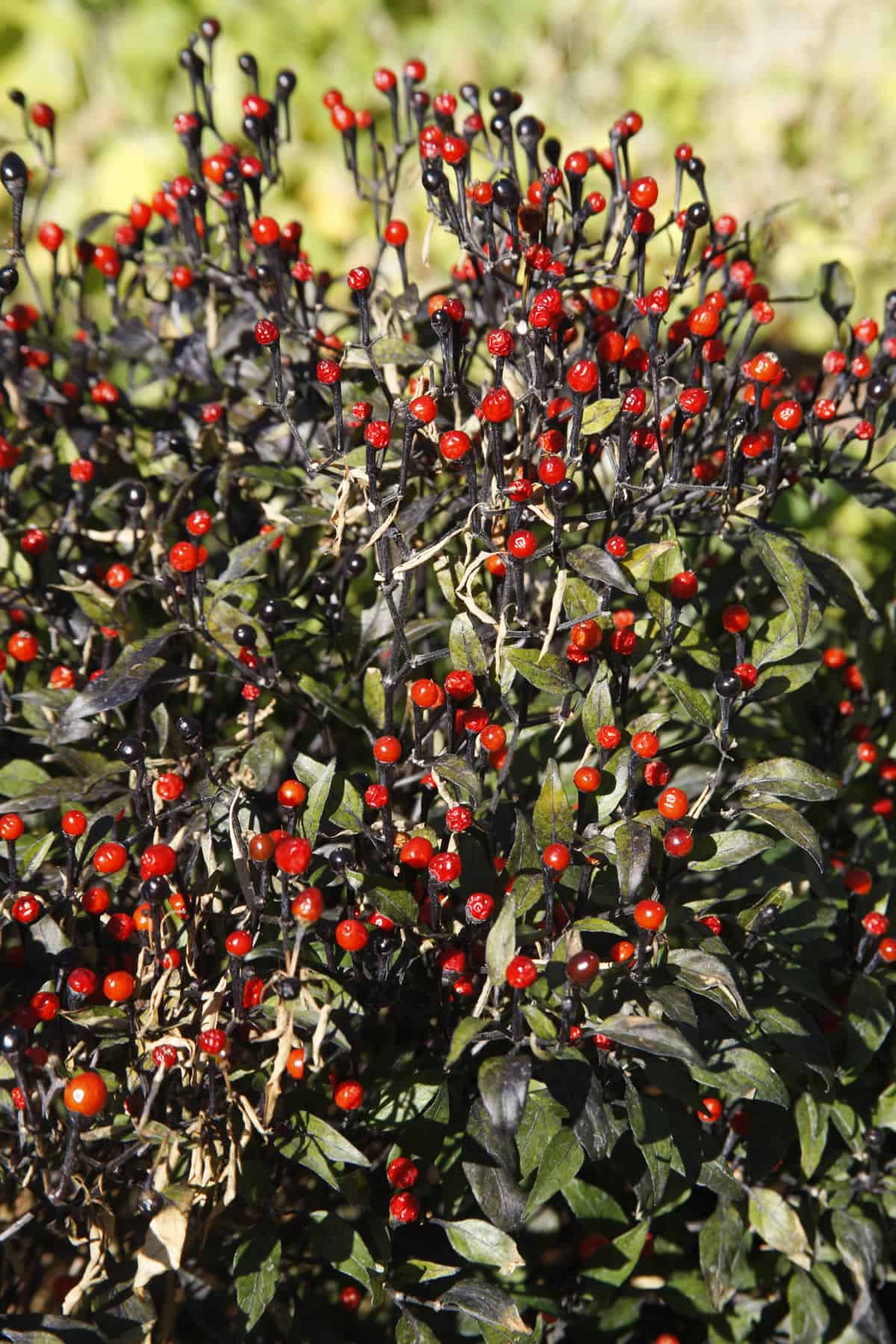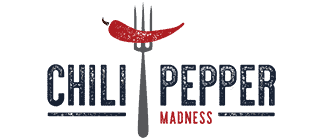The chiltepin pepper is a tiny, round or oval shaped chili pepper grown wild throughout much of the U.S. and Mexico. It is quite spicy, measuring up to 100,000 Scoville Heat Units. Learn More.

SCOVILLE HEAT UNITS: 50,000 to 100,000 SHU
Capsicum Annuum
The Chiltepin pepper, "chile tepin", or "Chiltepine", is a tiny, round or oval shaped, red to orange-red chile, measuring about .8 cm in diameter. It has grown in the wild throughout much of Northern Mexico and Southern United States for generations, and there is much folklore and history involving the plant in the US/Mexico Borderland areas.
It is the only wild native chili pepper in the United States, sometimes referred to as "The Mother of All Peppers".
Efforts to grow the wild plants on farms have led to the development of the Chile Piquin, which is grown commercially in Mexico and Texas.
In fact, Texas named the chiltepin the state’s “official native pepper” in 1997.
They are also called “bird peppers” because they are eaten and spread by wild birds, or "bird's eye peppers" because of their size.
History of the Chiltepin
The pepper has been widely used as not only a food, but as a medicine (because of the capsaicin content), for generations, even rising to mythic status. Even today, many locals hold iconic rituals where families come together to harvest wild chiltepins through the mountainous region. You can collect quite a few during the wild harvest.
It is said no home should be without a collection of the dried pods. It is even used as a preservative for meats.
Chiltepin peppers are protected in the US in Coronado National Forest, Big Bend National Park and Organpipe Cactus National Monument.
It has a rich history in the Native American culture and remains highly significant today to not only the people of the Sonoran region, but to the United States. It is definitely worth exploring and enjoying if you're a chilihead or spicy food lover.
How Hot is the Chiltepin Pepper?
The Chiltepin is quite hot, and in Mexico, the heat of the pepper is considered “arrebatado” which means “rapid” or “violent” because the intense heat is not long lasting, unlike many chili peppers that have a slower and more enduring effect.
The heat measures up to 100,000 Scoville Heat Units on the Scoville Scale, which is quite hot. Compare that to an average jalapeno pepper, which averages about 5,000 Scoville Heat Units, making the pepper up to 20 times hotter than a jalapeno.
A serrano pepper measures up to 23,000 SHU, so the Chiltepin can be more than 4 times hotter.
However, a chemical study made in 2015 measured these peppers at a range of 50,000 - 1,628,000 SHU, which would place them in the realm of the superhot chili peppers.
Eating Chiltepin Peppers
Chiltepin peppers are often dried and crushed for spices and seasoning, and used in soups, stews and bean dishes. The pepper has a distinctively smoky flavor. Sun-dried chiltepins is a favorite way to dehydrate them.
The green fruit can also be used in salsas to bring in a nice level of heat, or are sometimes pickled with other ingredients and spices for a relish-like condiment that can accompany any number of dishes.
They're also great for making hot sauce from them, though admittedly, you'll need a lot of them.
The peppers are a big part of Sonoran cuisine, as they are native to the area.
How to Dry Chiltepin Peppers
You can easily dry these peppers with a dehydrator by cleaning them, then drying them whole on dehydrator sheets in your dehydrator at 135-140 degrees F. You can also dry them in an oven if your temperatures can go that low.
Dry them whole, or you can attempt to sun dry them in the open air, but beware of moisture in the air. Otherwise, the peppers will rot.
Where Can You Buy Chiltepin Peppers?
You can usually purchase the dried pods online, or purchase seeds through online resources for growing in your own garden. Here are a couple affiliate links to help get you started.
Have any questions? Contact me anytime! Happy to help you learn more. -- Mike H.
NOTE: This post was updated on 12/22/20 to include new information. It was originally published on 10/3/13.


Esther Pierce, 81 years old says
Is the plant a perennial? Our plants in Ft Worth came back in Spring -
Mother harvested them and poured boiled vinegar to a glass shaker bottle and
we used it as vinegar shaken over our greens (spinach, kale, turnip,etc).
We called them turkey peppers because the wild turkeys ate them, which made
their meat hot !
Thanks!
Mike Hultquist says
Esther, these are hearty perennials in the right climate as they grow wild. Yes, nice and hot! I love how your mother used them. Perfect.
Debbie says
I currently live in Tucson and have a terrific Chiltepin plant. We are considering a move back to southern Ohio, and I was wondering if my plant could survive the winters there and if you have any tips for success.
Mike Hultquist says
Debbie, it would likely go dormant, but I do have some information here: https://www.chilipeppermadness.com/growing-chili-peppers/growing-chili-peppers-or-other-gardening-in-the-fall-and-winter/
Joseph R Ayers says
I have 4yr old plant in NE Ohio. Harvest fruits, dry them and use them to add heat/taste to a plethora of dishes. Also eaten raw, for bragging rights.
Mike H. says
That's amazing, Joseph! =)
Steve Goodrich says
I have 2 chiltepin plants that I brought indoors before a frost. On one, the peppers are a purple color. The other plant, which I grew last year then kept indoors over the winter, the peppers are all green.
If I pick them and put them on the counter, will they turn red do you think?
Mike Hultquist says
Steve, they might continue to ripen. I have a post to refer to here: https://www.chilipeppermadness.com/preserving-chili-peppers/how-to-ripen-unripe-peppers/
BRANDON HESS says
How many hours of dehydrator time is required?
Mike Hultquist says
Hours can vary, Brandon, based on amounts, sizes, etc, but they're small, so likely 6-8 hours, maybe more. See these posts:
https://www.chilipeppermadness.com/preserving-chili-peppers/drying-chili-peppers/
https://www.chilipeppermadness.com/preserving-chili-peppers/how-to-dehydrate-chili-peppers-and-make-chili-powders/
Brian says
I just picked 2 cups worth of the Chiltepins off the bushes in my backyard, how do I store them or should I dehydrate them right away?
Mike Hultquist says
I have information here on how to store peppers, Brian: https://www.chilipeppermadness.com/preserving-chili-peppers/how-to-store-peppers/. You can refrigerate for a bit, but they're small and rot more quickly. You might freeze or start dehydrating in small batches.
Brian says
I'm in New Braunfels and discovered them in a corner of my backyard, is there a way to harvest them other than picking them off one at a time? I must have about a dozen plants about 3' high.
Mike Hultquist says
Hi, Brian. I don't know of any other way to harvest than to pick them off. You can try shaking it, but that probably won't do a lot. I'm not sure if others have had a different experience.
Brian says
Thanks. I thought of cutting the plant near the base and letting them dry out wrap them in a sheet and shake the hell out of it and see if that works.
Paul says
You might try a cranberry harvesting tool, you can probably make one.